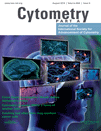 | |
| Discipline | Cytometry, medical imaging, cytology, histology |
|---|---|
| Language | English |
| Edited by | Bartek Rajwa |
| Publication details | |
Former name | Cytometry |
| Publisher | |
| Frequency | Monthly |
| Hybrid | |
| 4.355 (2020) | |
| Standard abbreviations | |
| ISO 4 | Cytom. A |
| Indexing | |
| CODEN | CYTODQ |
| ISSN | 1552-4922 (print) 1552-4930 (web) |
| LCCN | 2004212580 |
| OCLC no. | 52508910 |
| Links | |
Cytometry Part A is a peer-reviewed scientific journal covering all aspects of the study of cytometry that was established in 1980. [1] It is the official journal of the International Society for Advancement of Cytometry. [2]
Cytometry Part A focuses on molecular analysis of cellular systems as well as cell-based spectroscopic analyses and associated bioinformatics/computational methodologies.
Brian Mayall [3] [4] was the journal's founding editor-in-chief until 1998. Jan Visser [5] and Charles Goolsby [6] subsequently succeeded Brian Mayall in this position. Attila Tarnok [7] has served as the Journal's editor-in-chief from 2007 to 2024. In 2024 it was announced that Bartek Rajwa will be taking over as editor-in-chief [8]
This journal was formerly known as Cytometry and first published in July 1980 with ISSN 0196-4763. It has been published with ISSN 1552-4922 since 2003. Cytometry Part A is associated with Cytometry Part B , ISSN 1552-4930.
The journal is abstracted and indexed in:
According to the Journal Citation Reports, the journal has a 2020 impact factor of 4.355.